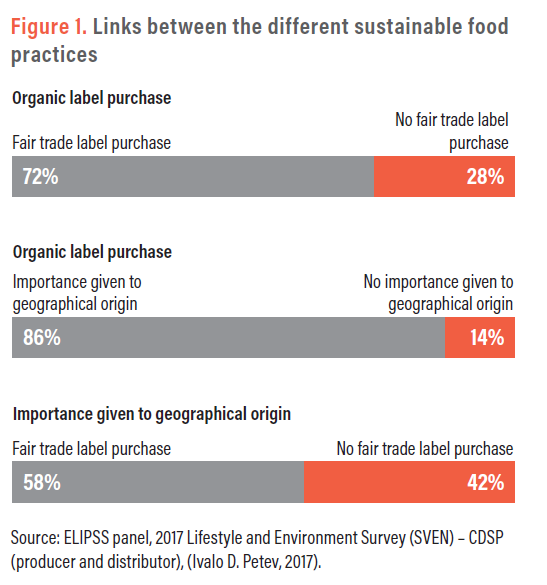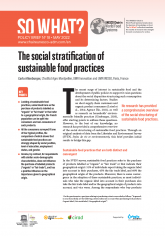Home > Publications > Policy Briefs > 18/ The social stratification of sustainable food practices
– Carla Altenburger, L’Institut Agro Montpellier, UMR Innovation and UMR IRISSO, Paris, France
– Looking at sustainable food practices, understood here as the purchase of products labelled as “organic” or “fair trade” or that refer to a geographical origin, the French population can be split into consumers and non-consumers of such products.
– All the consumers surveyed fit one of four typical profiles, the comparison of which shows that sustainable food practices are strongly shaped by social position, level of education, employment status, and gender.
– Income, by contrast, for respondents with similar socio-demographic characteristics, does not influence the purchase of labelled products (“organic” or “fair trade”), and has a positive influence on the importance given to geographical origin.
The recent surge of interest in sustainable food and the development of public policies to support it raise questions about the social disparities structuring such consumption and its determining factors. Studies on short supply chain customers and organic product consumers (Loisel et al., 2014; Agence Bio, 2021), as well as research on households’ environmentally friendly practices (Ginsburger, 2020), offer starting points to address these questions. However, to the best of our knowledge, no research has provided a comprehensive overview of the social structuring of sustainable food practices. Through an original analysis of data from the Lifestyles and Environment Survey (SVEN, Styles de vie et environnement), this brief provides initial results to bridge this gap.
In the SVEN survey, sustainable food practices refer to the purchase of products labelled as “organic” or “fair trade” or that indicate their geographical origin : 51% of individuals report taking the organic label into account in their purchases, 43% the fair trade label, and 66% the geographical origin of the products. Moreover, there is some convergence in the adoption of these sustainable practices, as most individuals who take the organic label into account in their purchases also take the fair trade label and/or the geographical origin of products into account, and vice versa. Among the respondents who buy products labelled “organic”, 72% also buy products labelled “fair trade”, and 86% take into account products’ geographical origin. Finally, 58% of those who take into account the origin of food products also buy fair trade products (Figure 1).

At a more detailed level, consumers as a whole can be split into four typical profiles, distinguishing between two groups of sustainable food consumers and two other categories made up of individuals who have not adopted such consumption practices.
The analysis reveals two typical profiles of individuals who adopt sustainable food practices (Table 1).
“Urban, affluent and highly educated consumers”
They account for 14% of consumers and are characterized by keen attention to the “organic” label (81%), the “fair trade” label (67%) and the geographical origin of the food products they purchase (89%). Forty-five per cent of these consumers purchase products from local farmers, organic shops or box schemes (AMAPs) once or twice a week, 47% buy their food on the market once or twice a week, and 50% buy products from specialty shops (bakers, butchers, cheesemongers, market gardeners) at least twice a week. Conversely, they do not visit supermarkets very often and 34% of them go to the supermarket less than once a week. The individuals who fit this profile are mainly from higher socio-professional categories (SPC), highly educated, and very well-off. Most of them live alone or with one other person (68%) and 17% of them live in the Paris conurbation.
Women and retirees
Women and retirees constitute the largest category of sustainable food consumers (together they account for 36% of the total sample), with a consumption of organic products (84%), fair trade products (74%) and local products (92%) that is even higher than that of “urban, affluent and highly educated consumers”. Fifty nine percent of the individuals matching this typical profile are women, and 28% are retirees. These variables bring into relief questions surrounding time availability and the evolution of food practices over the course of one’s life (Barrey et al., 2016). Unlike in the case of the first profile, the level of economic resources available is not a distinctive variable here, although the price of the products purchased is an important criterion. These individuals do visit farm shops, organic shops or box scheme collection points once or twice a week (39%), as well as food markets (50%), but they also go to the supermarket on a weekly basis. Finally, this profile differs from the first in that the individuals concerned also consume free and self-produced food (69%), a factor that may influence their food budget.
Two profiles were also identified among individuals who report that they do not consume sustainable products. Comparing their socio-economic characteristics with those of the previous profiles highlights the importance of the social determinants of this consumption (Table 1).
The “excluded”
This profile represents 34% of individuals who do not take sustainability criteria into account when buying food: 90% do not take into account the organic label, 92% the fair trade label and 61% products’ geographical origin. Most of them prefer to shop at the supermarket: 75% go there once a week. Comparing the characteristics of this profile with those of sustainable food consumers shows the effect of an individual’s social position and of their level of education. This profile includes a high proportion of unqualified blue-collar workers (18%) as well as individuals with a low level of education. The majority of these consumers are men (53%) and are employed (62%), which confirms the role that an individual’s gender and life stage play in the adoption of sustainable food practices. Some of these consumers have a difficult financial situation, with 4% earning between €1,000 and €1,200 per month and 6% reporting that they cannot get by without borrowing money. Finally, they live in large households and often in rural areas (30%).
The “indifferent”
16% of individuals do not fit any distinctive category as regards their consumption of sustainable products. They can be described as “indifferent”. All of the individuals in this group buy their food from supermarkets and half of them also visit specialty shops once or twice a week. They are characterized by a lower level of education and a higher unemployment rate than the categories represented by the other profiles, and they are in a difficult economic situation (21% report that they “struggle to get by financially”). They also live in large households and, similarly to the first profile, 16% of these respondents live in the Paris conurbation.
The typology presented above shows that the level of economic resources partly influences the adoption of sustainable food practices. However, analysis holding all other variables constant offers more detailed insight into the net effect of income on these practices compared to the other socio-demographic factors (SPC, level of education, gender, employment status, household size, place of residence). It shows that this effect varies, depending on the practice considered.
Contrary to what one might assume, a difference in income between individuals with a comparable social situation does not have a significant impact on the consumption of fair trade or organic products. All other things being equal, only very high-income earners making over €6,000 per month are significantly more likely to consume organic products than people earning less than €1,200 per month. Income does however have a positive effect on the importance given to the geographical origin of products. Individuals with equivalent socio-demographic characteristics earning between €2,000 and €6,000 per month pay significantly more attention to the origin of the food products they purchase than those with a monthly income of less than €1,200.
The analysis of the SVEN survey data confirms the social disparities that structure sustainable food consumption and reveals its determining factors. It corroborates the existence of a link between socio-demographic characteristics and sustainable food practices, and qualifies the effect of income on the adoption of these practices. The lack of economic resources or the higher price of sustainable products are therefore not the only obstacles: there are also social hurdles. As a result, public policies to make sustainable food more affordable may not be sufficient to ensure access for all. A qualitative survey on the practices and places of purchase of sustainable food would allow for identifying the social barriers that may compromise access to these products as well as public policy levers to overcome them.
The data from the Lifestyles and Environment Survey (SVEN) were produced by the Center for Socio-Political Data (CDSP-Sciences Po/CNRS, Centre de données socio-politiques) as part of the Longitudinal Internet Studies for Social Sciences panel (ELIPSS, Étude longitudinale par Internet pour les sciences sociales), an online panel representative of the population aged 18 to 79 living in mainland France. The randomly selected panellists answer surveys every month using a tablet and a mobile data plan made available to them for this purpose. The sample consists of 2,362 individuals. A multiple correspondence analysis (MCA) and a hierarchical ascending classification (HAC) were carried out using ten active variables characterizing the individuals’ food purchasing practices and the locations thereof, as well as eight additional socio-economic variables (socio-professional group, level of education, gender, occupation, household size, place of residence, level of income, and financial security). Additionally, three ordinal logistic regression models were run, taking the three sustainable food practices (purchasing products labelled “organic” or “fair trade” or that refer to a geographical origin) as modalities of interest, and the socio-economic characteristics used in the previous analyses as explanatory variables. Only financial security was removed, as it was too strongly correlated with income. The analysis was conducted on a weighted sample.
– Carla Altenburger, L’Institut Agro Montpellier, UMR Innovation and UMR IRISSO, Paris, France
Agence Bio, 2021. Baromètre de consommation et de perception des produits biologiques en France. Paris : Spirit Insight et Agence Bio, 123 p.
Barrey S., Dubuisson-Quellier S., Gojard S., Plessz M., 2016. Les effets du gouvernement sur les conduites : le rôle des bifurcations des trajectoires de vie dans les changements de conduite de consommation. Dans : Dubuisson-Quellier S. (éd.). Gouverner les conduites. Paris : Presses de Sciences Po, p. 193-228.
Ginsburger M., 2020. De la norme à la pratique écocitoyenne : position sociale, contraintes matérielles et diversité des rapports à l’écocitoyenneté. Revue française de sociologie, 61(1), p. 43-78.
Petev I. D. , Demoli Y., SVEN team, ELIPSS team [authors], Styles de vie et environnement (2017) [fichier électronique], Fondation nationale des sciences politiques (FNSP) [productor], Centre de données socio-politiques (CDSP) [distributor], Version 1.
Loisel J.-P., François M., Chiffoleau Y., Hérault-Fournier C., Sirieix L., Costa S., 2014. La consommation alimentaire en circuits courts : enquête nationale. Paris : Gret, 50 p.
